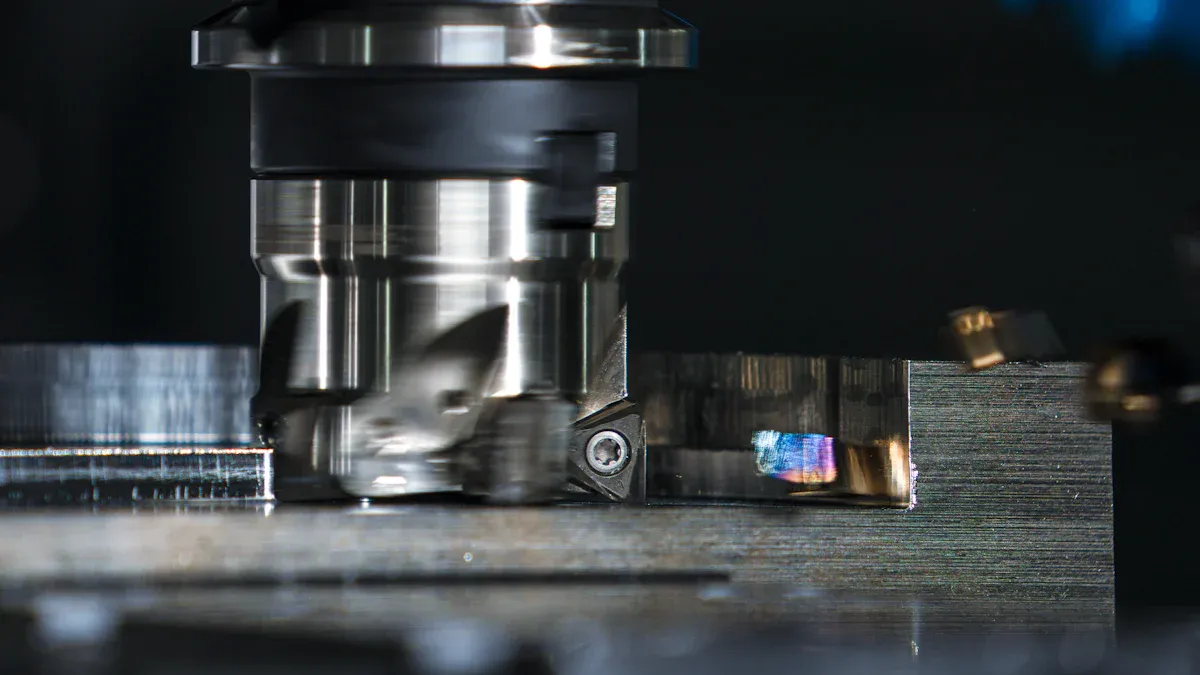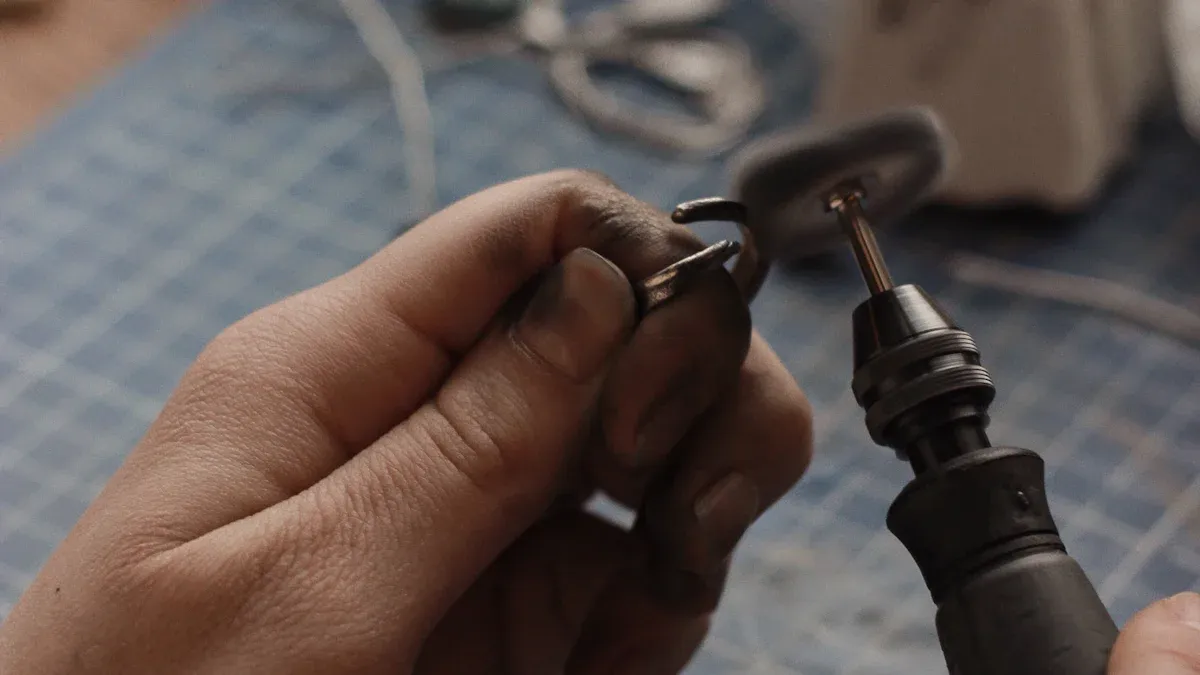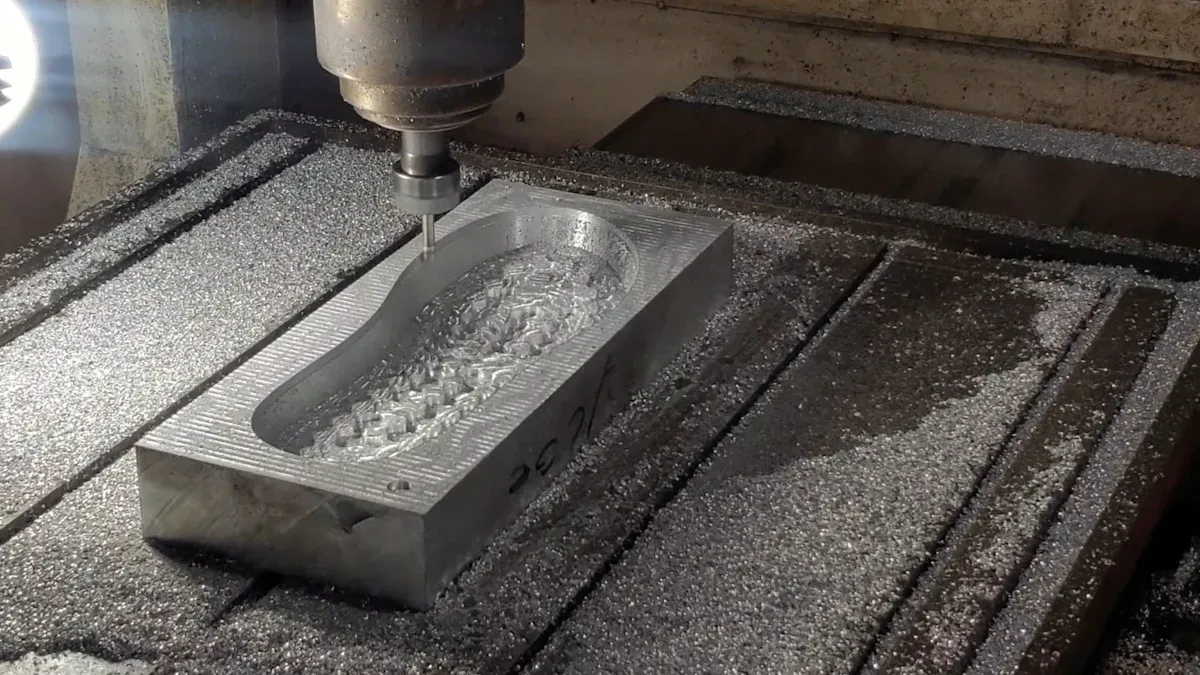
Injection mold polishing plays a vital role in achieving high-gloss, defect-free surfaces. It ensures that finished products meet aesthetic and functional standards. Industries like automotive, consumer goods, and electronics rely heavily on this process to enhance product appeal and performance. For example, hardened tool steel molds are often chosen for their ability to create smooth finishes, which are essential for high-quality results.
Polishing methods vary depending on the material and surface roughness. A typical process involves using sand grades from 320 # to 1500 #. Each step reduces imperfections and prepares the mold for finer finishes. High-gloss surfaces not only improve transparency but also reduce corrosion risks, making them indispensable in precision manufacturing.
Injection mold polishing is a critical process in the plastic mold industry. It involves refining the mold's surface to achieve a brighter, smoother finish, often resembling a mirror. This process enhances both the quality and aesthetics of the final product. You’ll find that polished mold surfaces are essential for creating high-gloss parts, especially in industries like consumer goods and medical devices.
Polishing serves several purposes. First, it improves the mold's resistance to corrosion and wear, extending its lifespan. Second, it simplifies the demolding process, ensuring the product maintains its integrity. Lastly, it reduces friction during molding, which minimizes defects like scratches or warping. By achieving a high-quality surface finish, you can ensure that the final product has a high-gloss appearance and meets industry standards.
High-gloss surfaces are defined by their smoothness and flawless appearance. These surfaces are not only visually appealing but also durable. To achieve this, a combination of mechanical and chemical polishing methods is often used. The table below highlights key characteristics of high-gloss surfaces based on industry standards:
| Characteristic | Description | Standard Level |
|---|---|---|
| Surface Finish | A smooth, flawless finish is essential for aesthetic appeal and durability. | SPI A or SPI B |
| Polishing Methods | Combination of mechanical and chemical methods for high-gloss finishes. | High-gloss |
When you aim for a high-gloss appearance, it’s important to focus on achieving a polished mold surface that meets these standards. This ensures the final product not only looks great but also performs well in its intended application. High-polish parts, such as those used in transparent plastic products, require precision and attention to detail during the polishing process.
Injection mold polishing plays a key role in creating visually appealing products. A polished mold surface ensures that the final product has a high-gloss finish, which is essential for industries like automotive, consumer goods, and electronics. You’ll notice that products with a smooth and reflective surface stand out due to their premium appearance. This is especially important for items like car interiors, electronic casings, and luxury goods.
The demand for high-quality injection moulding surface finish has grown significantly. The mold polishing stone market, for example, has experienced a Compound Annual Growth Rate (CAGR) of approximately 6% in recent years. This growth reflects the increasing need for precision finishing in sectors such as automotive and electronics. A smooth surface finish not only enhances the product's gloss but also improves its overall surface quality, making it more attractive to consumers.
Polishing techniques also impact the ease of manufacturing. A polished mold allows for better ejection of plastic parts, reducing the risk of scratches or marks. This ensures that the final product maintains its aesthetic appeal. By focusing on achieving a reflective surface, you can create products that meet the highest standards of design and quality.
Polishing does more than enhance aesthetics. It also improves the performance and lifespan of the mold itself. A smooth mold surface reduces friction during the injection molding process. This minimizes wear and tear, ensuring that the mold remains functional for a longer period. You’ll find that a well-polished mold requires less maintenance, saving both time and money.
Corrosion resistance is another benefit of mold polishing. A polished surface prevents moisture and chemicals from damaging the mold. This is particularly important in industries that use aggressive materials or operate in harsh environments. By investing in proper polishing techniques, you can protect your molds from premature degradation.
Additionally, a high-quality injection moulding surface finish ensures consistent production. A smooth mold surface allows for uniform material flow, reducing the likelihood of defects. This not only improves the efficiency of the manufacturing process but also ensures that every product meets the desired specifications.
Defects like scratches, warping, or uneven surfaces can ruin the quality of a product. Injection mold polishing helps eliminate these issues by creating a flawless mold surface. A smooth and reflective surface ensures that the final product is free from imperfections, enhancing its functionality and appearance.
Polishing also reduces the risk of material buildup on the mold. This is crucial for maintaining a consistent surface finish across multiple production cycles. You’ll notice that products made with polished molds have fewer defects, resulting in higher customer satisfaction.
In industries like medical devices and aerospace, precision is critical. A polished mold ensures that every detail of the product is accurate. This level of precision not only improves the product's performance but also builds trust in your brand. By prioritizing mold polishing, you can achieve superior results and maintain a competitive edge in the market.

When it comes to polishing plastic injection mold surfaces, you’ll find several methods available. Each method offers unique advantages depending on the mold material, surface requirements, and production goals. Understanding the types of mold polishing methods will help you choose the best approach for your project.
Mechanical polishing is one of the most common mold polishing techniques. It involves using abrasive tools like sandpaper, polishing stones, or rotary equipment to smooth and refine the mold surface. You’ll often start with coarse abrasives to remove major imperfections and gradually switch to finer grades for a mirror-like finish.
Tip: When using mechanical polishing, ensure you follow a step-by-step process. Start with lower grit abrasives and progress to higher grit levels for optimal results.
Mechanical polishing is ideal for molds used in industries like automotive and consumer goods. It’s especially effective for achieving textured finishes that enhance product aesthetics.
Chemical polishing uses chemical solutions to dissolve and smooth the surface of the mold. This method is particularly useful for intricate designs and hard-to-reach areas where mechanical tools may struggle. You’ll find it effective for achieving uniform finishes on complex molds.
Note: Always handle chemical solutions with care. Wear protective gear and follow safety guidelines to avoid accidents.
Chemical polishing is commonly used in industries like medical devices and electronics, where precision and smoothness are critical. It complements other mold polishing techniques by addressing areas that mechanical methods cannot reach.
Ultrasonic polishing is a modern technique that uses high-frequency vibrations to polish the mold surface. This method relies on ultrasonic waves to agitate abrasive particles, which then smooth the mold. You’ll find it particularly effective for delicate molds and textured surfaces.
Callout: Ultrasonic polishing is a great choice for molds requiring mirror processing or high-gloss finishes.
This technique is widely used in industries like aerospace and medical devices, where precision and durability are essential. It’s also gaining popularity for polishing plastic injection mold surfaces due to its efficiency and reliability.
Electropolishing and fluid polishing are advanced techniques that refine mold surfaces to achieve exceptional smoothness and precision. These methods are particularly effective for intricate molds and high-gloss finishes, making them valuable in industries like medical devices, aerospace, and electronics.
Electropolishing uses an electrochemical process to remove a thin layer of material from the mold's surface. This method smooths out microscopic imperfections and enhances the mold's overall quality. You’ll find it especially useful for achieving a mirror-like finish on metal molds.
How It Works: 1. The mold is submerged in an electrolyte solution. 2. An electric current passes through the mold, dissolving surface irregularities. 3. The process leaves behind a polished, corrosion-resistant surface.
Advantages of Electropolishing: - Precision: It removes material at a microscopic level, ensuring a flawless finish. - Corrosion Resistance: The process enhances the mold's ability to withstand harsh environments. - Consistency: It delivers uniform results, even on complex mold designs.
Tip: Electropolishing works best for stainless steel molds and other conductive materials. Always consult a professional to determine if this method suits your project.
Fluid polishing, also known as abrasive flow machining, uses a pressurized abrasive fluid to polish the mold's surface. This technique is ideal for molds with hard-to-reach areas or intricate details.
How It Works: 1. A semi-liquid abrasive material flows through the mold. 2. The abrasive particles smooth the surface by removing imperfections. 3. The process continues until the desired level of polish is achieved.
Advantages of Fluid Polishing: - Versatility: It can polish both simple and complex mold geometries. - Efficiency: The abrasive fluid reaches areas that traditional methods cannot. - Customizability: You can adjust the abrasive material and pressure to meet specific polishing requirements.
Callout: Fluid polishing is a great choice for molds used in industries requiring high precision, such as aerospace and medical devices.
Both electropolishing and fluid polishing offer unique benefits that complement other mold polishing methods. By understanding these techniques, you can select the best approach for your project and achieve superior results.
The material of your mold plays a crucial role in determining the best polishing method. Different substrates require specific techniques to achieve optimal results. For example, glass-filled resins demand diamond-chrome coatings due to their high abrasion resistance and low friction. On the other hand, nickel boron nitrite works well for low-end glass-filled materials, aiding in resin flow and part release.
Here’s a quick reference table to help you match materials with suitable polishing methods:
| Material Type | Polishing Method | Key Properties |
|---|---|---|
| Glass-filled resins | Diamond-chrome coating | High abrasion resistance, low coefficient of friction |
| Low-end glass-filled materials | Nickel boron nitrite | Aids in resin flow and part release |
| High-glass-filled materials | Diamond-chrome coating | Excellent for abrasion protection |
| General mold surfaces | Polishing techniques (blasting, stoning) | Smooth finish, reduces downtime and part failure |
By understanding the properties of your mold material, you can select a polishing method that enhances durability and ensures a flawless finish.
The complexity of your mold design directly impacts the polishing process. Simple designs are easier to polish, while intricate molds with tight tolerances or undercuts require advanced techniques. Over-engineered designs often lead to manufacturability issues, increasing tooling costs and polishing challenges.
A thorough Design for Manufacturability (DFM) analysis can help you identify unnecessary complexities and streamline the polishing process. Consider the following factors:
| Factor | Impact on Injection Molding Processes |
|---|---|
| Part Design Simplicity | Over-engineered designs can lead to manufacturability issues and increased complexity in tooling. |
| Tooling Costs | Higher complexity molds result in increased tooling costs due to features like tight tolerances and undercuts. |
| Design for Manufacturability (DFM) | A thorough DFM analysis is crucial to minimize tooling and production costs, ensuring complex features are necessary. |
By simplifying your mold design, you can reduce polishing time and costs while maintaining high-quality results.
Polishing costs and time vary based on mold surface complexity and smoothness requirements. Precise polishing methods, such as diamond-chrome coatings, can be expensive but offer long-term benefits like enhanced durability. Coating treatments like chrome and nickel plating require significant investment but improve mold performance over time.
For cost-effective options, consider nitriding. This method enhances wear resistance and provides a good balance between cost and performance. Here are some key points to keep in mind:
- Polishing costs increase with mold complexity and smoothness requirements.
- Coating treatments, though costly, improve mold durability and reduce maintenance needs.
- Nitriding offers a budget-friendly solution with excellent wear resistance.
By evaluating your budget and production timeline, you can choose a polishing method that aligns with your goals and delivers the best return on investment.

Proper preparation of the mold surface sets the foundation for successful injection mold polishing. Start by thoroughly cleaning the mold to remove any dirt, grease, or residue. Contaminants can interfere with the polishing process and lead to uneven results. Use a solvent or cleaning agent suitable for the mold material to ensure a clean surface.
Inspect the mold for any visible defects, such as scratches, dents, or burrs. Address these imperfections before polishing to avoid amplifying them during the process. For example, burrs along ejector pin locations can be eliminated through mold maintenance and process optimization, as seen in real-world cases involving consumer electronics casings. By resolving these issues early, you can achieve a smoother and more consistent finish.
Choosing the right mold polishing tools and materials is crucial for achieving high-quality results. Smaller abrasive sizes create smoother surfaces and reduce scratch damage. Harder abrasives also minimize scratches under similar conditions. Refer to the table below for a quick comparison:
| Abrasive Size | Surface Smoothness | Effect on Scratch Damage |
|---|---|---|
| Smaller | Smoother | Less damage |
| Larger | Rougher | More damage |
When selecting tools, consider the mold material and desired finish. For intricate designs, ultrasonic polishing tools work well. For general surfaces, mechanical tools like polishing stones or sandpaper are effective. Always match the tool to the task to ensure optimal results.
Injection mold polishing often presents challenges, such as flash formation, burrs, or uneven finishes. Tackling these issues requires a combination of mold modifications and process adjustments. For instance, in router housing production, switching materials caused flash formation. Adjusting the mold and refining the process resolved the issue, improving efficiency.
Implementing industry best practices can also help you overcome challenges. Adhering to ISO 9000 standards ensures consistent quality. Advanced inspection tools and Statistical Process Control (SPC) allow you to monitor critical parameters like cavity pressure and melt temperature. These measures help detect variations early, ensuring a flawless finish.
By preparing the mold surface, selecting the right tools, and addressing challenges proactively, you can master the best practices for effective mold polishing. This approach ensures consistent results and enhances the quality of your final products.
Consistency and quality control in mold polishing are essential for achieving flawless results. Without these, even the most advanced polishing techniques can fail to deliver the desired outcome. You must adopt a systematic approach to ensure every mold meets the required standards.
Start by implementing a clear set of guidelines for your polishing process. Document each step, from surface preparation to the final inspection. This ensures that every team member follows the same procedures, reducing variability in results. Regular training sessions can also help your team stay updated on the latest polishing techniques and tools.
Use inspection tools to monitor the quality of your work. Devices like profilometers measure surface roughness, while microscopes help identify imperfections invisible to the naked eye. These tools allow you to detect and correct issues early, ensuring a consistent finish across all molds.
Establish checkpoints during the polishing process. For example, inspect the mold after each stage of abrasive use. This helps you identify problems before they escalate, saving time and resources. You can also use statistical process control (SPC) to track key parameters like surface smoothness and material removal rates.
Finally, maintain detailed records of your polishing projects. Track the tools, materials, and methods used for each mold. This data helps you identify patterns and refine your processes over time. By prioritizing quality control in mold polishing, you can consistently produce high-quality molds that meet industry standards.
Tip: Regularly calibrate your inspection tools to ensure accurate measurements. This small step can make a big difference in maintaining consistency.
Injection mold polishing is essential for achieving flawless, high-gloss surfaces that enhance product quality and durability. You’ve learned about various polishing methods, including mechanical, chemical, and ultrasonic techniques, and how to choose the right one based on material and design. By following best practices like proper surface preparation and quality control, you can improve your polishing process. Apply these insights to create superior molds and elevate your manufacturing results. Consistency and attention to detail will ensure long-term success in your projects.
Begin by cleaning the mold thoroughly. Remove dirt, grease, or residue using a suitable solvent. Inspect the surface for defects like scratches or burrs. Address these issues before polishing to ensure a smooth and consistent finish.
Tip: Always start with coarse abrasives and gradually move to finer grades for better results.
Consider the mold material, design complexity, and desired finish. For intricate designs, ultrasonic or chemical polishing works best. Mechanical polishing suits general surfaces. Evaluate your budget and production timeline to select the most efficient method.
Note: Consult a professional if unsure about the best technique for your project.
Yes, polishing reduces friction and wear during the molding process. A smooth surface prevents material buildup and corrosion, extending the mold's lifespan. Regular maintenance and polishing ensure consistent performance over time.
You’ll need abrasive tools like polishing stones, sandpaper, or rotary equipment. For intricate molds, ultrasonic polishing tools are ideal. Chemical solutions may also be necessary for hard-to-reach areas.
Callout: Match your tools to the mold material and design for optimal results.
Follow a systematic process. Use inspection tools like profilometers to measure surface roughness. Establish checkpoints after each polishing stage. Train your team regularly and document your methods to maintain consistency.
Tip: Calibrate your inspection tools frequently for accurate measurements.